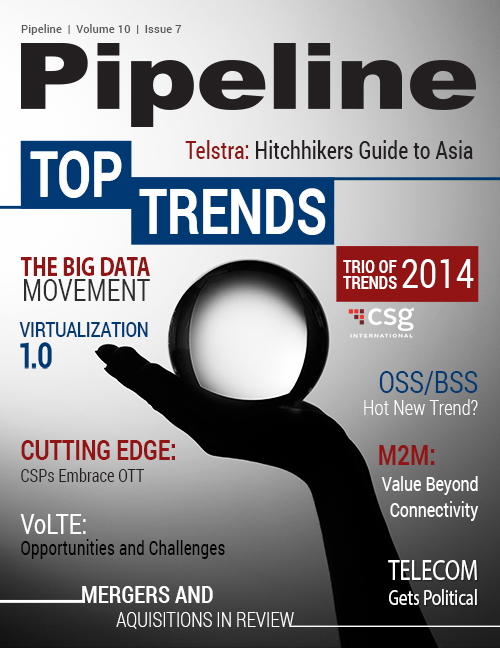The Big Data Movement
Furthermore, significant organizational hurdles must be overcome. In its extensive study “The Emerging Returns on Big Data,” TCS argues that the largest challenge CSPs face isn’t technical—it’s getting internal groups to share data across silos. Plus, across the board there is a general lack of data scientists available for businesses to hire: the people who can drive large-scale Big Data implementations are just beginning to graduate from colleges.
How are CSPs spending their Big Data dollars, and what are the results?
Service providers are throwing gobs of money at Big Data, but the top category in terms of spending may surprise you: staffing. “We estimate that in Big Data initiatives, salaries account for about half of the current spending, with the other half allocated to vendors’ products and services,” said ABI Research senior analyst Aapo Markkanen in a September news release. “What we’re now seeing is quite significant overspending on salaries, as organizations turn to data scientists and other specialists in order to leverage Big Data in the first place.” ABI estimates that $15.5 billion will be spent on data scientists’ salaries in 2013 alone.
Once staff are in place, CSPs are spending on four main initiatives:
- real-time mobile-network optimization;
- promotions and marketing;
- customer-service initiatives/customer experience management (CEM);
- customer-data monetization/data reselling.
Telefónica emerged as the first Big Data telco when it launched a separate Big Data business in October of last year: Telefónica Dynamic Insights (TDI) enables its business customers to monetize customer data from the Telefónica network, and its first product, Smart Steps, helped leading UK supermarket chain Morrisons increase its base of new or returning shoppers by 150 percent.
TDI also joined the Open Data Institute (ODI) in July. The company’s goal, according to a blog post written by CEO Steve Alder, is to “explore how anonymized and aggregated data can be used in a responsible way to deliver benefits back to business and society.”
Meanwhile, Sprint has been actively investing in Big Data to improve network management and capacity, which in turn improves the customer experience, reduces churn and lowers network error rates. “The goal is to look forward into predictive mode to make adjustments in real time—that’s really what we’re trying to do from the network side with Big Data,” said Von McConnell, director of innovation and advanced labs for Sprint, in a video interview for IBM earlier this year. “What we’re trying to do now is take all these systems—and we have lots of systems—and we’re trying to understand how these systems work together, what those systems are, how they’re different, how they interact together.
“We’re actually going to start inserting real-time analytics into the call-processing network,” he added. “We’ve had almost a 90 percent increase in capacity right out of the [gate].”
Sprint, like many other CSPs, is also investing in the monetization of customer data. “We have an opportunity to create a new market segment,” said McConnell, in which “we can help our customers, our business customers, to understand their traffic, understand the opportunities that are occurring in the marketplace at any time.”
Big Data began to pay off in 2013: statistics from Tata Consultancy Services indicate that the telecommunications industry also sells far more data than any other industry—50 percent of telecom companies, to be exact, compared to 38 percent of utilities, the runner-up—and is monetizing it fairly well. Internally as well, CSPs around the world are seeing positive results from Big Data implementations. According to recent IBM case studies, Big Data is the secret sauce in these particular outcomes:
- XO Communications realized annual customer-experience-related savings of $15 million;
- Pakistan-based Ufone doubled its marketing-offer acceptance rate;
- the effectiveness of Globe Telecom’s promotional efforts improved by 600 percent.
The vendor market
Big Data is good news for vendors too. The addressable market is increasing, and telcos are outsourcing more and more Big Data projects. The consulting firm Ovum predicts that while CSPs will remain cautious with their overall IT spending, they’ll increase their investment in projects that require specialized skills, such as Big Data initiatives.
IBM, Intel and HP lead the overall Big Data market, primarily due to the vast deployment footprint of their hardware, with Teradata, Dell, Oracle, and SAP, among others, providing the competition. Telecom vendors are moving up the food chain, however, and offer compelling Big Data platforms that are telecom specific.
Ericsson has emphasized its domination among network equipment manufacturers (NEM) to make a case for its Big Data solutions, while Lavastorm, a provider of business-intelligence and analytic tools, is also addressing the data-analyst deficit. “With our solutions, we lower the barrier to analytics,” said Mark Marinelli, the company’s vice president of product management, in a recent interview with Pipeline. “We bring the right tools that allow a business analyst to perform analysis above their pay grade.”
Companies with a legacy of service assurance, such as NetScout and Monolith, are leveraging their pervasive network visibility to inform business and operational intelligence. Other companies to watch in the Big Data space include three As: Accanto, Amdocs and AsiaInfo.



















